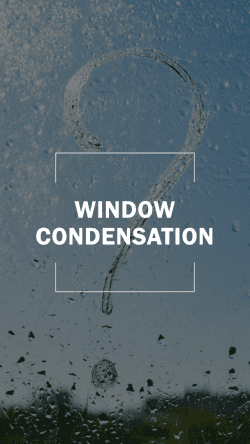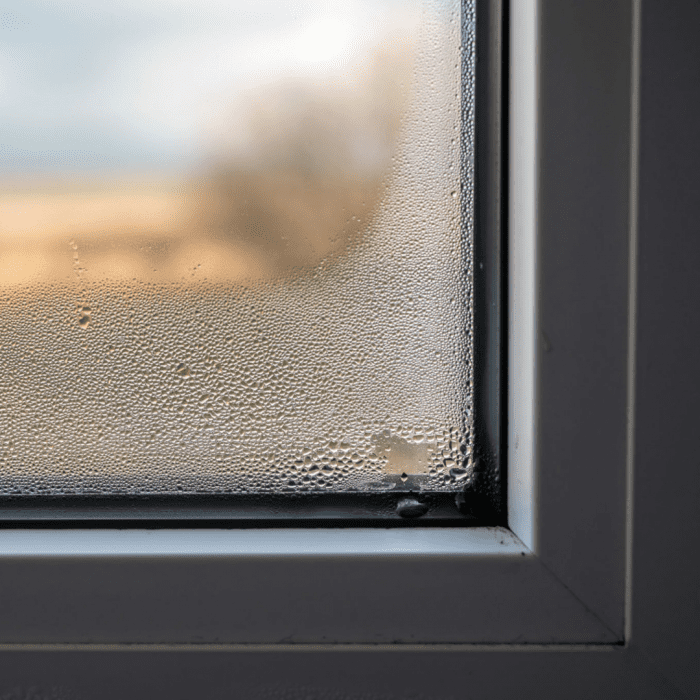Window Condensation Facts

Why does condensation form on my windows? Should I be worried about condensation on my windows? In this article, we’ll address these window condensation frequently asked questions.
If you’re noticing condensation on your windows, you might be wondering whether or not you should be worried. The answer usually depends on where the condensation is forming. Is it on the inner side of the window, in between two panes of glass, or on the outside?
First, let’s go over the basics about condensation on your windows.
What is condensation?
Condensation is the process where water vapor in the air changes state from a gas to a liquid, forming tiny droplets. It occurs when warm, moist air comes into contact with a cooler surface, like the glass in a window. The extra moisture condenses on the colder surfaces, forming visible water droplets.
Why does condensation form on windows?
Windows are often the first place you see condensation because they are typically colder than the air inside your home. This is especially true in winter when the outside temperature is much lower than the inside temperature. Here’s the breakdown:
- Warm, moist air: Activities like cooking, showering, and even just breathing add moisture to the air inside your home. This warm air can hold a lot of water vapor.
- Cool window pane: The glass in your window loses heat to the colder outside air, making it cooler than the surrounding air inside.
- Moisture meets cold: As the warm, moist air comes into contact with the cool window pane, it can no longer hold all the water vapor. This excess moisture condenses on the glass, forming those familiar droplets.
By understanding the science behind window condensation, you can take steps to reduce it, like controlling humidity levels, improving ventilation, and considering double-paned windows for better insulation.
Foggy Windows and Condensation Inside Your Home
Have you ever peered through a window clouded with condensation, longing for a clear view? While it might seem like something’s wrong with the windows themselves, they’re simply reacting to high indoor humidity.
Humidity is the amount of water vapor in the air, and it rises with everyday activities like cooking, showering, and even breathing. While some humidity is beneficial, too much can lead to condensation, fogging up your view, dripping on the floor, or even freezing on the glass.
While occasional condensation isn’t a major issue, persistent condensation can be a sign of high humidity in your home. High indoor humidity can lead to more than just foggy windows; it can cause serious damage like:

- Mold and mildew growth: Flourishing in damp environments, these harmful organisms can trigger allergies, irritate respiratory systems, and damage furniture and belongings.
- Cracked, peeling, or blistering paint: Excess moisture weakens the bond between paint and surfaces, leading to unsightly and costly repairs.
- Wood rot: If the moisture penetrates beyond the surface, it can lead to wood rot in window frames, especially in older wooden windows. This can weaken the structural integrity of the windows and require costly repairs.
- Warped window frames: In extreme cases, prolonged exposure to high humidity can cause wooden window frames to warp or swell, making them difficult to open and close properly.
- Damage to window seals: The moisture can also deteriorate the seals around your windows, leading to drafts, increased energy bills, and further condensation issues.
If you’re seeing frequent foggy windows, especially in winter, take action and reduce your indoor humidity. Indoor humidity levels can be a problem for both your health and your home when they fall outside the ideal range, typically between 30% and 50%.
Ways to reduce indoor humidity and prevent condensation on the inside of your windows:
- Improve ventilation: Open windows regularly, especially after cooking, showering, or doing laundry. Use exhaust fans in kitchens and bathrooms to remove moisture quickly. Vent all gas appliances, clothes dryers, and exhaust fans to the outside. Consider installing a whole-house ventilation system for continuous air circulation.
- Reduce moisture sources: Long, hot showers are major contributors to indoor humidity. Opt for shorter, cooler showers to minimize steam production. Fix any leaky faucets or pipes to prevent moisture buildup.
- Invest in Double-pane or insulated windows: Single-pane windows are more susceptible to condensation and moisture damage than double-pane or insulated windows. Double-paned windows have better thermal resistance, keeping the inner pane warmer.
- Maintain proper HVAC maintenance: Ensure your air conditioner and heating system are functioning properly to manage humidity effectively.
- Invest in a Dehumidifier: This useful appliance actively removes excess moisture from the air. Choose one appropriate for your home’s size and humidity levels, and run it strategically in moisture-prone areas like bathrooms and laundry rooms.
- Address leaks promptly: Fix any leaky faucets or pipes to prevent moisture buildup.
By addressing indoor humidity, you can enjoy clearer windows, a healthier home, and peace of mind.
Condensation between your window glass
While condensation forming on the inner surface of your window is a common sight, discovering condensation trapped between the glass panes of a double-pane, or dual-pane, window signifies a different issue. This foggy layer, unlike its single-pane counterpart, isn’t simply a matter of high indoor humidity. It points to a breach in the window’s seal.
Imagine your dual-pane window as two glass sandwiches with an insulating gas (usually argon) trapped between them. This gas acts as a barrier, keeping the inner pane warm and the outer pane cool, preventing the conditions necessary for condensation to form. However, over time, the seal around the edges of the panes can weaken due to:
- Normal wear and tear: Seals naturally degrade with age and exposure to the elements.
- Manufacturing defects: While less common, faulty seals can occur during the window’s production.
- Physical damage: Accidental impacts or improper installation can compromise the seal’s integrity.
When the seal fails, moist air infiltrates the space between the panes, encountering the cool inner glass and forming the telltale condensation. This not only obstructs your view but also:
- Reduces the window’s insulating ability: The trapped moisture negates the insulating properties of the argon gas, making your home less energy-efficient.
- Creates a breeding ground for mold: The stagnant, humid environment between the panes can become a haven for mold growth, posing health risks and further damaging the window components.
What to do when condensation strikes between the panes:
Unfortunately, condensation between double-pane windows is not easily remedied. Attempts to remove the moisture internally or reseal the window yourself are often ineffective and can void any warranties. The most straightforward solution is to have a professional replace the glass or the affected window unit. Dick’s Rancho Glass can replace the glass efficiently and promptly and your new glass will come with a ten year warranty protecting you from this happening again.
While replacing window panes can seem daunting, consider it an investment in your home’s comfort and energy efficiency. Modern double-paned windows offer superior insulation and durability, making them a worthwhile upgrade in the long run.
Prevention is key:
While not always preventable, you can minimize the risk of seal failure by:
- Choosing high-quality windows and glass doors: Opt for reputable brands, such as Milgard windows and patio doors, known for their durable seals and construction.
- Proper installation: Ensure qualified professionals install your windows to avoid any seal damage.
- Regular maintenance: Inspect your windows for signs of wear and tear, including any condensation between the panes, and address any concerns promptly.
By understanding the causes and consequences of condensation between double-pane windows, you can make informed decisions about their repair or replacement.
Condensation on the outside of your windows
The most common time to see outside condensation is in early mornings. When the sun hasn’t risen yet, the window glass has cooled down overnight while the outside air remains humid from the previous day. As the sun rises and warms the air, the condensation usually disappears. This can also happen in summer when the air conditioning cools the window glass below the dew point of the outside air.
Condensation on the outside of your window is not a cause for concern. It’s actually a sign that your windows are doing their job effectively by preventing heat transfer from inside to outside or vice versa. of course, persistent condensation can be a sign of excessively high humidity levels outside, which could lead to other problems like mold growth in your siding or roof.
Window condensation mysteries solved! Whether it occurs inside, outside, or between window panes, we see that each has its own causes and concerns. But only one means a window problem: fog or water droplets between glass panes. That’s a broken seal, time for a fix by Dick’s Rancho Glass. Give us a call, contact us online, or visit one of our two glass showrooms in the Sacramento region:
Dick’s Rancho Glass Sacramento at 2900 ROUTIER ROAD; Phone: (916)363-6554
Dick’s Rancho Glass Fair Oaks at 5349 SAN JUAN AVE. Phone: (916)863-2500
